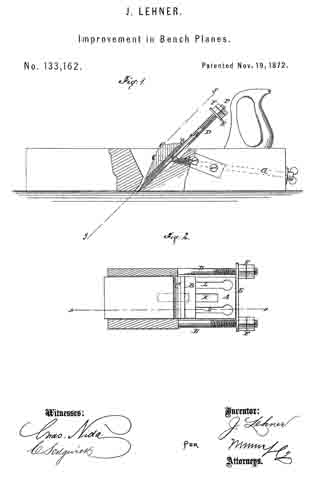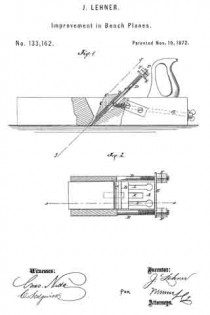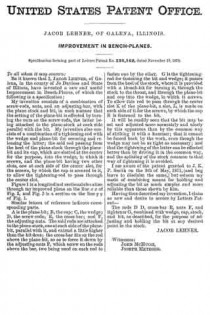No. 133,162 – Improvement In Bench-Planes (Jacob Lehner) (1872)

UNITED STATES PATENT OFFICE.
_________________
JACOB LEHNER, OF GALENA, ILLINOIS.
IMPROVEMENT IN BENCH-PLANES.
_________________
Specification forming part of Letters Patent No. 133,162, dated November 19, 1872.
_________________
To all whom it may concern:
Be it known that I, JACOB LEHNER, of Galena, in the county of Jo Daviess and State of Illinois, have invented a new and useiul Improvement in Bench-Planes, of which the following is a specification:
My invention consists of a combination of screw-rods, nuts, and an adjusting-bar, with the plane stock and bit, in such manner that the setting of the plane-bit is effected by turning the nuts on the screw-rods, the latter being attached to the plane-stock at each side parallel with the bit. My invention also consists of a combination of a tightening-rod with the wedge and plane-bit for securing and releasing the latter; the said rod passing from the heel of the plane-stock through the plane-bit and its cap, which are slotted at the center for the purpose, into the wedge, in which it screws, and the plane-bit having two other slots, one at each side of the center slot, for the screws, by which the cap is secured to it, to allow the tightening-rod to pass through the center slot.
Figure 1 is a longitudinal sectional elevation through my improved plane on the line x x of Fig. 2, and Fig. 2 is a section on the line y y of Fig. 1.
Similar letters of reference indicate corresponding parts.
A is the plane-bit; B, the cap; C, the wedge; D, the screw-rods; E, the cross-bar; and F, the adjusting-nuts. The said rods are attached to the plane-stock, one at each side of the plane-bit, parallel with it, and extend a little higher than the bit does; the cross-bar fits on the rod above the plane-bit, so as to force it down by the adjusting-nuts F, which screw on the rods above the bar, two being used on each rod to fasten one by the other. G is the tightening-rod for fastening the bit and wedge; it passes from the heel of the stock, where it is provided with a thumb-bit for turning it, through the stock to the throat, and through the plane-bit and cap into the wedge, in which it screws. To allow this rod to pass through the center slot K of the plane-bit, a slot, L, is made on each side of it for the screws, by which the cap B is fastened to the bit.
It will be readily seen that the bit may be set and adjusted more accurately and nicely by this apparatus than by the common way of striking it with a hammer; that it cannot be forced back by the work, even though the wedge may not be as tight as necessary; and that the tightening of the latter can be effected better than by driving it in the common way, and the splitting of the stock common to that way of tightening it is avoided.
I am aware ofthe patent granted to J. K. P. Smith on the 9th of May, 1871, (and beg leave to disclaim the same,) but esteem my mode of combining means for holding and adjusting the bit as much simpler and more reliable than those shown by him.
Having thus described my invention, I claim as new and desire to secure by Letters Patent —
The rods D D, cross-bar E, nuts F, and tightener G, combined with wedge, cap, stock, and bit, as described, for the purpose of adjusting and holding the bit at any desired point in the stock.
JACOB LEHNER.
Witnesses:
JOHN McHUGH,
JOSEPH METZGER.


